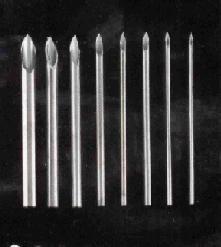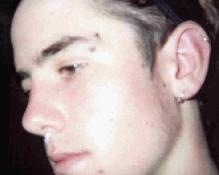| SKINDEEPSTEEL body piercing
About Skin Deep Steel
Skin Deep pictures
What's New with Skin Deep steel
Contact Skin Deep Steel
Piercing Information
History of piercing
Price List
Skin Deep Catalog
Skin Deep catalog 2
Gauge and size guide
Skin Deep Links
Guest Book Page
|
|
|
AFTERCARE, PIERCING DO'S AND DON'TS, WHY GET A PIERCING.
In this page you will find some general piercing information such as aftercare instructions, piercing do's and don'ts, why to get a piercing/basic history of piercing. feel free to copy and print information found in this area of the site.
|
 WE ONLY USE STERILIZED SINGLE USE NEEDLES
All of our needles are autoclave sterilized. Needles are only used once. and are destroyed after use.
WE ONLY USE STERILIZED SINGLE USE NEEDLES
All of our needles are autoclave sterilized. Needles are only used once. and are destroyed after use. |
|
piercing do's and don'ts
DON'T get any piercing done with a ear-piercing gun or cheap ear studs.
DO verify the piercer uses one-use-only hollow needles, sterilized forceps, latex gloves, and other procedures to prevent infection or disease transmission.
DON'T get a piercing at a convention of any sort. It's the worst possible situation for the piercer, you, and your piercing.
DO select a time when you are healthy, well-rested, and mentally ready for the piercing. If you aren't sure, you aren't ready. Eat a balanced meal 2-4 hours before the piercing. (If you can't get a meal, tell the piercer so you can be given a soda or juice to boost your blood sugar before the piercing.)
DON'T accept "temporary" or "starter" jewelry. A professional piercer will be honest; if what you need isn't in stock, he/she will say so. You'll be happier waiting for the right jewelry than if you "make do."
DO ask to have each step explained to you. (Before the piercing, if you'd rather not know exactly what's happening when.)
DON'T fail to tell the piercer if you have any medical conditions, medications, or other health concerns which may affect the piercing procedure or healing. They may make a difference in placement, timing, or aftercare. If you don't trust the piercer enough to tell him/her the truth, you haven't found the right piercer. (A professional will keep the information confidential.)
DO obtain and read complete, written aftercare instructions. Ask questions about caring for your specific piercing, if general instructions are given.
DON'T accept the myth that "all piercings get infected." Piercings shouldn't get infected. And won't, if the piercing was done correctly and you take proper care of it.
DO follow the aftercare instructions. If you are instructed to clean the piercing twice a day for six months, do it. Even if the piercing appears fully healed and in good condition. (Navel and nipple piercings, especially, are notorious for "flaring up" if you stop early.)
DON'T remove or replace jewelry earlier than specified. If you must remove it temporarily, use nylon monofilament in the same size as the jewelry gauge to keep the piercing open; replace the original jewelry as soon as possible.
DO call or visit the piercer if you have any questions or concerns about your piercing. If you aren't comfortable with the quality of the piercer, consider visiting another studio for a "second opinion."
DON'T hesitate to seek medical help if:
The jewelry is pulled out (splitting the skin).
The piercing gets seriously infected and doesn't clear up within a few days of proper care. A nostril or septum piercing becomes infected. (It's
true nose infections can be very serious or even
fatal.)
DO replace original jewelry (if desired after fully healed) with body jewelry of equal quality (surgical grade stainless steel, 14K or higher yellow gold, or niobium/titanium). If you absolutely have to wear non-body jewelry, wear it through an "ear thimble" (a.k.a "eyelet"). These are specially made tubes of surgical stainless steel or niobium which will protect your body from the "whatever" you want to wear. Thimbles are available in 12g. and larger (the piercing must be
one gauge larger to accommodate the flared ends of the thimble).
and finally,
DO be proud of your body piercing. It's as special as you are!
|
|
AFTER CARE INSTRUCTIONS
You will be provided with complete instructions for caring for your new piercing. Aftercare procedures are specific to the kind of piercing but, in general, cleanliness and minimal stress on the piercing site will produce the quickest healing. As with any opening in the skin, the piercing must be protected when engaging in
activities where body fluids could come into contact with the unhealed piercing (including saliva from kissing or licking).
Aftercare must be continued throughout the healing period. If it is stopped too soon, the piercing will almost always become infected. The healing time for piercings varies a great deal from a few weeks to a year or longer.
NEVER handle a new piercing with dirty hands! Wash hands and fingertips well.
Avoid any introduction of foreign bodily fluid to the area (sweat, blood, saliva, etc.)
Do not harass the piercing's healing process by
wearing constrictive clothing or allowing repeated
bumping and knocking around the jewelry.
Use caution when swimming during healing; poor water quality and high bacteria presence will infect your new piercing. Some people will run Vaseline or Neosporin liberally through the hole prior to a swim in order to seal off the exposed tissue temporarily. In this case, soak well with salt water and clean immediately afterwards.
Listen to your body's reactions to various products. Some ingredients commonly found in skincare products can irritate the vulnerable tissue in new piercings. Eliminating variables in product exposure will often solve occasional irritation.
ALL new piercings will secrete a gooey, sticky fluid called lymph. This will dry up and form a ring of crust on the jewelry at the piercing's holes, making moving the jewelry painful. Soaking and cleaning this lymph DAILY (or as the build-up requires) is necessary to avoid any problems with bacteria populations.
Don't remove the jewelry until well after the piercing is completely healed.
Once healed, a piercing is permanent, although when the jewelry is removed, the displacement will cause the hole to shrink, making jewelry re-insurtion difficult without first gently stretching the hole back up to size.
New piercings heal the best when the aftercare
products do not interfere with the cell regeneration process. Products like ALCOHOL and PEROXIDE are not recommended as they often harass the newly-healing cells. Salt water is by far the least-reactive and most effective cleaning solution. Bacitracin Zinc is one of the best antibiotic ointments. Some people have
also successfully used Bactine, Betadine, Hibiclens, Benzalkonium Chloride, Campho Phenique, and D-Alpha Vitamin E oil as part of their cleaning regimen. No product is universally good for all types of skin, except salt water.
If an irritation persists despite eliminating product types, a metal allergy may be the culprit. Try changing the jewelry with the help of a piercing professional.
WHY GET A PIERCING
why get a piercing?
There are as many reasons to get piercings as there are people. Some find body jewelry particularly attractive in its own right. Traditional piercings and styles may reconnect or reinforce an individual with his ethnic roots. Others use piercings (as well as tattoos,
brandings, and cuttings) to make a statement about
themselves and their attitude towards society's
conservative rules, or to indicate membership in a
particular group. Still others have discovered that
nipple and genital piercings can heighten the sexual experience for themselves and their partners.
For many people, body piercings are used to celebrate or mark a special moment in their lives, such as a birthday, the birth or death of someone important to them, or the beginning or end of a stage of life. Piercings may be used to reclaim one's "self" after a relationship ends, or to celebrate the beginning of a relationship. Couples are choosing body jewelry to mark engagements, weddings, and anniversaries, instead of traditional jewelry.
Piercings are used in the rituals of some religions,particularly to mark the passage into adulthood. They may also be used within a SM scene, either to heighten the experience (and leave a memorable token) or to cement a specific relationship, such as between a Mistress and slave.
Whatever the reason, body adornment has a long and
colorful history. Modern society is only now
rediscovering the beauty and joy of piercings. As a
result of this new interest, unique forms of piercing have been added to the traditional ones.
The one drawback to this increased interest is that
people desiring piercings cannot always find a trained, experienced piercer. For your safety and health, always ask about your intended piercer's training, methods, and sterile procedures. Never allow anyone to use an ear-piercing gun on you not even to pierce your ears. It is far better to wait for that desired piercing until you can find someone you can trust to use the proper equipment, procedures, and jewelry, than to suffer the
effects of a poor piercing.
|
 always follow the aftercare instructions of your piercer
If you don't follow the aftercare instructions, your piercing could get severly infected
always follow the aftercare instructions of your piercer
If you don't follow the aftercare instructions, your piercing could get severly infected |
never allow anyone to use a piercing gun on you
NEVER! alow any one to use a piercing gun on you. piercing with a gun shoves a blunt piece of metal through your body (piercing studs). some people have had their bellybuttons pierced with guns DON'T EVER DO THIS IT IS VERY DANGEROUS!!! if this is your only option don't get the piercing. there is a very large chance of serious infection. piercing guns are un-sterile, they are merely sprayed with alcohol before use. this does not sterilize it.
piercing studs are packaged in a factory without being sterilized. get piercings only with sterilized single use needles. |
|
|


